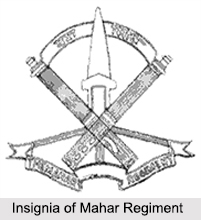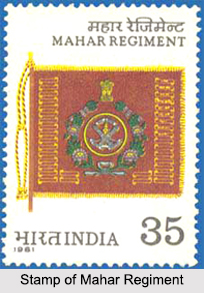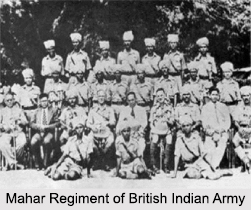 The Mahar Regiment was one of the infantry regiments of the British Indian Army. It served under the British administration from the year 1941 to 1947. After the Indian Independence, the army unit was assigned to the modern Army of India. Presently, it is the only unit in the Indian Army which consists of military personnel from all regions and communities of the country.
The Mahar Regiment was one of the infantry regiments of the British Indian Army. It served under the British administration from the year 1941 to 1947. After the Indian Independence, the army unit was assigned to the modern Army of India. Presently, it is the only unit in the Indian Army which consists of military personnel from all regions and communities of the country.
History of Mahar Regiment
The Mahars were originally enlisted and recruited by the Emperor Shivaji as fort guards and scouts for his army. Later the British East India Company recruited them to be part of the Bombay Army of Bombay Presidency. The Mahar troops in the Bombay Army were renowned for their valour. They provided significant military service during the Anglo Maratha Wars. The Mahar Regiment of the 2nd Battalion and 1st Regiment of Bombay Native Light Infantry defeated the infantrymen of the Peshwa Army during the Battle of Koregaon. An obelisk was established as a commemoration of the battle. It was known as Koregaon pillar and it was featured in the crest of Mahar Regiment. The troops of the Bombay Army also served during the Sepoy Mutiny in 1857.
 In the year 1892, it was decided by the British Empire in India to establish class regiments in the British Indian Army. The troops of the Mahar regiment were excluded from the class regiments. It was also notified that some of the classes, including the Mahars, were no longer needed to be enlisted. The Mahar troops who were a part of the 104 Viceroy`s Commissioned Officers and other Non-commissioned officers were dismissed. Later the leaders of the Mahar community made several attempts to convince the British Government of India to recruit the Mahars again. The troops were also supported by the Indian National Congress Party who opposed to the recruiting policies of the British Indian Army. However, these policies of the British Army in India remained until 1914 when the First World War was commenced. Due to the Great War, the British administration began to recruit heavily and the Mahar troops were enlisted again into the army.
In the year 1892, it was decided by the British Empire in India to establish class regiments in the British Indian Army. The troops of the Mahar regiment were excluded from the class regiments. It was also notified that some of the classes, including the Mahars, were no longer needed to be enlisted. The Mahar troops who were a part of the 104 Viceroy`s Commissioned Officers and other Non-commissioned officers were dismissed. Later the leaders of the Mahar community made several attempts to convince the British Government of India to recruit the Mahars again. The troops were also supported by the Indian National Congress Party who opposed to the recruiting policies of the British Indian Army. However, these policies of the British Army in India remained until 1914 when the First World War was commenced. Due to the Great War, the British administration began to recruit heavily and the Mahar troops were enlisted again into the army.
The 111th Mahars were formed in June 1917. However, it was amalgamated with the 71st battalion, Punjab Regiment in 1920. Eventually it was dissolved in March 1921 and the Mahar troops were again discharged. But after the outbreak of the Second World War in 1939, the British Indian Army was compelled to change its recruitment policies.
In July 1941, Dr. B. R. Ambedkar exerted pressure in the British Indian Army to establish a Mahar regiment. Later in October 1941, the first Battalion of the Mahar Regiment was formed by the British administration. It was established in Belgaum and was led by Lieutenant Colonel H. J. R. Jackson of the 13th Frontier Force Rifles. A second Battalion was also formed in June 1942 in Kamptee. It was led by Lieutenant Colonel J. W. K. Kirwan. The cap badge of the regiment featured the Koregaon Pillar and the word "Mahar". The third battalion, the 25th Mahars, was formed in August 1942 in Belgaum by Lieutenant Colonel V. Chambier. The third Mahars were formed by Lieutenant Colonel R. N. D. Frier in Nowshera.
During World War II, the first Mahars and third Mahars were stationed in the North West Frontier Province. The second Mahars and 25th Battalions were engaged in internal security duties in British India. The second Battalion also provided military service in the Burma Campaign as a part of the 23rd Indian Division. The troops also served in Iraq as a part of PAIFORCE after the Second World War.
 The 25th Mahars infantry regiment was dissolved in 1946 along with several other British Indian garrison battalions. The Mahar Regiment was modified into a Machine Gun Regiment in October 1946. The cap badge was also changed accordingly. The new badge included two crossed Vickers machine guns over the Koregaon Pillar, and the words "The Mahar MG Regiment". The Regimental Centre was formed at Kamptee (Kamthi in Nagpur District in Maharashtra state). The three remaining battalions of the Mahar Regiment provided service as a part of the Punjab Boundary Force. The army unit assisted in escorting refugees during the Partition of India.
The 25th Mahars infantry regiment was dissolved in 1946 along with several other British Indian garrison battalions. The Mahar Regiment was modified into a Machine Gun Regiment in October 1946. The cap badge was also changed accordingly. The new badge included two crossed Vickers machine guns over the Koregaon Pillar, and the words "The Mahar MG Regiment". The Regimental Centre was formed at Kamptee (Kamthi in Nagpur District in Maharashtra state). The three remaining battalions of the Mahar Regiment provided service as a part of the Punjab Boundary Force. The army unit assisted in escorting refugees during the Partition of India.
Development of Mahar Regiment
After the withdrawal of the British Empire in India in the year 1947 and the Partition of India, the British Indian Army was divided along with the nation. The Mahar Regiment was assigned to the Union of India and the modern Indian Army.
The Border Scouts were formed during the Partition of India by the people of the border villages in East Punjab. The troops defended villages from various attacks during partition. Later, they were given a permanent designation as the East Punjab Frontier Scouts in 1948. The unit was designated as the first Battalion, second Battalion and third Battalion of the Border Scouts in the year 1951. Later, in 1956, the unit was transformed into Machine Gun Regiments and the three battalions were united with the Mahar Regiment. These units were designated as the fourth Battalion, fifth Battalion and sixth Battalion of the Mahar Regiment. The three Battalions were named as the battalions of the Mahar Regiment (Borders).
Units of Mahar Regiment
The units of the Mahar Regiment are listed below:
•1st Battalion
•2nd Battalion
•3rd Battalion
•4th Battalion (Borders)
•5th Battalion (Borders)
•6th Battalion (Borders)
•7th Battalion
•8th Battalion
•9th Battalion
•10th Battalion
•11th Battalion
•12th Battalion
•13th Battalion
•14th Battalion (previously 31st Mahar)
•15th Battalion (previously 32nd Mahar)
•17th Battalion
•18th Battalion
•19th Battalion
•20th Battalion
•21st Battalion
Former Battalions of Mahar Regiment
The former battalions of Mahar Regiment are as follows:
•25th Battalion (dissolved in 1946)
•16th Battalion (previously 8th Parachute Regiment)
Allied Units of Mahar Regiment
Allied units of Mahar Regiment are enlisted below:
•108th Infantry Battalion Territorial Army
•115th Infantry Battalion Territorial Army
•1st Battalion Rashtriya Rifles
•30th Battalion Rashtriya Rifles
•51st Battalion Rashtriya Rifles



















